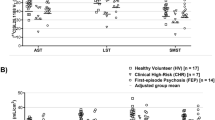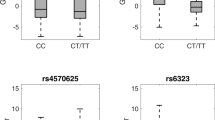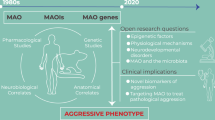Abstract
Antisocial personality disorder (ASPD) often presents with highly impulsive, violent behavior, and pathological changes in the orbitofrontal cortex (OFC) and ventral striatum (VS) are implicated. Several compelling reasons support a relationship between low monoamine oxidase-A (MAO-A), an enzyme that regulates neurotransmitters, and ASPD. These include MAO-A knockout models in rodents evidencing impulsive aggression and positron emission tomography (PET) studies of healthy subjects reporting associations between low brain MAO-A levels and greater impulsivity or aggression. However, a fundamental gap in the literature is that it is unknown whether brain MAO-A levels are low in more severe, clinical disorders of impulsivity, such as ASPD. To address this issue, we applied [11C] harmine PET to measure MAO-A total distribution volume (MAO-A VT), an index of MAO-A density, in 18 male ASPD participants and 18 age- and sex-matched controls. OFC and VS MAO-A VT were lower in ASPD compared with controls (multivariate analysis of variance (MANOVA): F2,33=6.8, P=0.003; OFC and VS MAO-A VT each lower by 19%). Similar effects were observed in other brain regions: prefrontal cortex, anterior cingulate cortex, dorsal putamen, thalamus, hippocampus, and midbrain (MANOVA: F7,28=2.7, P=0.029). In ASPD, VS MAO-A VT was consistently negatively correlated with self-report and behavioral measures of impulsivity (r=−0.50 to −0.52, all P-values<0.05). This study is the first to demonstrate lower brain MAO-A levels in ASPD. Our results support an important extension of preclinical models of impulsive aggression into a human disorder marked by pathological aggression and impulsivity.
Similar content being viewed by others

Log in or create a free account to read this content
Gain free access to this article, as well as selected content from this journal and more on nature.com
or
References
Alia-Klein N, Goldstein RZ, Kriplani A, Logan J, Tomasi D, Williams B et al (2008). Brain monoamine oxidase A activity predicts trait aggression. J Neurosci 28: 5099–5104.
Blair RJ (2004). The roles of orbital frontal cortex in the modulation of antisocial behavior. Brain Cogn 55: 198–208.
Blair RJ (2008). The amygdala and ventromedial prefrontal cortex: functional contributions and dysfunction in psychopathy. Philos Trans R Soc Lond B Biol Sci 363: 2557–2565.
Bortolato M, Chen K, Shih JC (2008). Monoamine oxidase inactivation: from pathophysiology to therapeutics. Adv Drug Deliv Rev 60: 1527–1533.
Bottlaender M, Valette H, Delforge J, Saba W, Guenther I, Curet O et al (2010). In vivo quantification of monoamine oxidase A in baboon brain: a PET study using [(11)C]befloxatone and the multi-injection approach. J Cereb Blood Flow Metab 30: 792–800.
Brunner HG, Nelen M, Breakefield XO, Ropers HH, van Oost BA (1993). Abnormal behavior associated with a point mutation in the structural gene for monoamine oxidase A. Science 262: 578–580.
Buckholtz JW, Treadway MT, Cowan RL, Woodward ND, Benning SD, Li R et al (2010). Mesolimbic dopamine reward system hypersensitivity in individuals with psychopathic traits. Nat Neurosci 13: 419–421.
Cases O, Seif I, Grimsby J, Gaspar P, Chen K, Pournin S et al (1995). Aggressive behavior and altered amounts of brain serotonin and norepinephrine in mice lacking MAOA. Science 268: 1763–1766.
Caspi A, McClay J, Moffitt TE, Mill J, Martin J, Craig IW et al (2002). Role of genotype in the cycle of violence in maltreated children. Science 297: 851–854.
Costa PT Jr., McCrae RR (1992) Revised NEO Personality Inventory (NEO-PI-R) and NEO Five-Factor Inventory (NEO-FFI). Psychological Assessment Resources: Odessa, FL.
Dalley JW, Everitt BJ, Robbins TW (2011). Impulsivity, compulsivity, and top-down cognitive control. Neuron 69: 680–694.
Duvernoy H (1999) The Human Brain: Surface, Blood Supply and Three Dimensional Section Anatomy. SpringerWien: New York, NY.
Finberg JP, Wang J, Goldstein DS, Kopin IJ, Bankiewicz KS (1995). Influence of selective inhibition of monoamine oxidase A or B on striatal metabolism of L-DOPA in hemiparkinsonian rats. J Neurochem 65: 1213–1220.
First MB, Gibbon M, Spitzer RL, Williams JBW, Benjamin LS (1997) Structured Clinical Interview for DSM-IV Axis II Personality Disorders, (SCID-II). American Psychiatric Press, Inc.: Washington, DC.
First MB, Spitzer RL, Gibbon M, Williams JBW (2002) Structured Clinical Interview for DSM-IV-TR Axis I Disorders, Research Version, Patient Edition (SCID-I/P). Version 2, Biometrics Research, New York State Psychiatric Institute: New York, NY.
Ginovart N, Meyer JH, Boovariwala A, Hussey D, Rabiner EA, Houle S et al (2006). Positron emission tomography quantification of [11C]-harmine binding to monoamine oxidase-A in the human brain. J Cereb Blood Flow Metab 26: 330–344.
Glenn AL, Yang Y (2012). The potential role of the striatum in antisocial behavior and psychopathy. Biol Psychiatry 72: 817–822.
Godar SC, Bortolato M, Frau R, Dousti M, Chen K, Shih JC (2011). Maladaptive defensive behaviours in monoamine oxidase A-deficient mice. Int J Neuropsychopharmacol 14: 1195–1207.
Hamdi NR, Iacono WG (2014). Lifetime prevalence and co-morbidity of externalizing disorders and depression in prospective assessment. Psychol Med 44: 315–324.
Hare R (2003) Hare Psychopathy Checklist-Revised 2nd Edn Multi-Health Systems: Toronto, Canada.
Hilton J, Yokoi F, Dannals RF, Ravert HT, Szabo Z, Wong DF (2000). Column-switching HPLC for the analysis of plasma in PET imaging studies. Nucl Med Biol 27: 627–630.
Huang YY, Grailhe R, Arango V, Hen R, Mann JJ (1999). Relationship of psychopathology to the human serotonin1B genotype and receptor binding kinetics in postmortem brain tissue. Neuropsychopharmacology 21: 238–246.
Lawrence AD, Brooks DJ (2014). Ventral striatal dopamine synthesis capacity is associated with individual differences in behavioral disinhibition. Front Behav Neurosci 8: 86.
Leyton M, Vezina P (2014). Dopamine ups and downs in vulnerability to addictions: a neurodevelopmental model. Trends Pharmacol Sci 35: 268–276.
Logan J, Fowler JS, Volkow ND, Wolf AP, Dewey SL, Schlyer DJ et al (1990). Graphical analysis of reversible radioligand binding from time-activity measurements applied to [N-11C-methyl]-(−)-cocaine PET studies in human subjects. J Cereb Blood Flow Metab 10: 740–747.
Matthews BA, Kish SJ, Xu X, Boileau I, Rusjan PM, Wilson AA et al (2014). Greater monoamine oxidase A binding in alcohol dependence. Biol psychiatry 75: 756–764.
Mawlawi O, Martinez D, Slifstein M, Broft A, Chatterjee R, Hwang DR et al (2001). Imaging human mesolimbic dopamine transmission with positron emission tomography: I. Accuracy and precision of D(2) receptor parameter measurements in ventral striatum. J Cereb Blood Flow Metab 21: 1034–1057.
Mejia JM, Ervin FR, Baker GB, Palmour RM (2002). Monoamine oxidase inhibition during brain development induces pathological aggressive behavior in mice. Biol Psychiatry 52: 811–821.
Meyer JH, Wilson AA, Rusjan P, Clark M, Houle S, Woodside S et al (2008). Serotonin2A receptor binding potential in people with aggressive and violent behaviour. J Psychiatry Neurosci 33: 499–508.
Mitchell DG, Colledge E, Leonard A, Blair RJ (2002). Risky decisions and response reversal: is there evidence of orbitofrontal cortex dysfunction in psychopathic individuals? Neuropsychologia 40: 2013–2022.
Moffitt TE, Caspi A, Harrington H, Milne BJ (2002). Males on the life-course-persistent and adolescence-limited antisocial pathways: follow-up at age 26 years. Dev Psychopathol 14: 179–207.
Murrough JW, Czermak C, Henry S, Nabulsi N, Gallezot JD, Gueorguieva R et al (2011a). The effect of early trauma exposure on serotonin type 1B receptor expression revealed by reduced selective radioligand binding. Arch Gen Psychiatry 68: 892–900.
Murrough JW, Henry S, Hu J, Gallezot JD, Planeta-Wilson B, Neumaier JF et al (2011b). Reduced ventral striatal/ventral pallidal serotonin1B receptor binding potential in major depressive disorder. Psychopharmacology (Berl) 213: 547–553.
O'Carroll AM, Fowler CJ, Phillips JP, Tobbia I, Tipton KF (1983). The deamination of dopamine by human brain monoamine oxidase. Specificity for the two enzyme forms in seven brain regions. Naunyn Schmiedebergs Arch Pharmacol 322: 198–202.
Petry NM (2002). Discounting of delayed rewards in substance abusers: relationship to antisocial personality disorder. Psychopharmacology (Berl) 162: 425–432.
Popova NK, Maslova LN, Morosova EA, Bulygina VV, Seif I (2006). MAO A knockout attenuates adrenocortical response to various kinds of stress. Psychoneuroendocrinology 31: 179–186.
Popova NK, Skrinskaya YA, Amstislavskaya TG, Vishnivetskaya GB, Seif I, de Meier E (2001). Behavioral characteristics of mice with genetic knockout of monoamine oxidase type A. Neurosci Behav Physiol 31: 597–602.
Rajkowska G, Goldman-Rakic PS (1995). Cytoarchitectonic definition of prefrontal areas in the normal human cortex: I. Remapping of areas 9 and 46 using quantitative criteria. Cereb cortex 5: 307–322.
Rubio G, Jimenez M, Rodriguez-Jimenez R, Martinez I, Avila C, Ferre F et al (2008). The role of behavioral impulsivity in the development of alcohol dependence: a 4-year follow-up study. Alcohol Clin Exp Res 32: 1681–1687.
Rusjan P, Mamo D, Ginovart N, Hussey D, Vitcu I, Yasuno F et al (2006). An automated method for the extraction of regional data from PET images. Psychiatry Res 147: 79–89.
Rylands AJ, Hinz R, Jones M, Holmes SE, Feldmann M, Brown G et al (2012). Pre- and postsynaptic serotonergic differences in males with extreme levels of impulsive aggression without callous unemotional traits: a positron emission tomography study using (11)C-DASB and (11)C-MDL100907. Biol Psychiatry 72: 1004–1011.
Saudou F, Amara DA, Dierich A, LeMeur M, Ramboz S, Segu L et al (1994). Enhanced aggressive behavior in mice lacking 5-HT1B receptor. Science 265: 1875–1878.
Saura J, Kettler R, Da Prada M, Richards JG (1992). Quantitative enzyme radioautography with 3H-Ro 41-1049 and 3H-Ro 19-6327 in vitro: localization and abundance of MAO-A and MAO-B in rat CNS, peripheral organs, and human brain. J Neurosci 12: 1977–1999.
Schuback DE, Mulligan EL, Sims KB, Tivol EA, Greenberg BD, Chang SF et al (1999). Screen for MAOA mutations in target human groups. Am J Med Genet 88: 25–28.
Scott AL, Bortolato M, Chen K, Shih JC (2008). Novel monoamine oxidase A knock out mice with human-like spontaneous mutation. Neuroreport 19: 739–743.
Soliman A, Bagby RM, Wilson AA, Miler L, Clark M, Rusjan P et al (2011). Relationship of monoamine oxidase A binding to adaptive and maladaptive personality traits. Psychol Med 41: 1051–1060.
Son SY, Ma J, Kondou Y, Yoshimura M, Yamashita E, Tsukihara T (2008). Structure of human monoamine oxidase A at 2.2-A resolution: the control of opening the entry for substrates/inhibitors. Proc Natl Acad Sci USA 105: 5739–5744.
Swann AC, Lijffijt M, Lane SD, Steinberg JL, Moeller FG (2009). Trait impulsivity and response inhibition in antisocial personality disorder. J Psychiatr Res 43: 1057–1063.
Sweitzer MM, Allen PA, Kaut KP (2008). Relation of individual differences in impulsivity to nonclinical emotional decision making. J Int Neuropsychol Soc 14: 878–882.
Uylings HB, Sanz-Arigita EJ, de Vos K, Pool CW, Evers P, Rajkowska G (2010). 3-D cytoarchitectonic parcellation of human orbitofrontal cortex correlation with postmortem MRI. Psychiatry Res 183: 1–20.
Zhou J, Witt K, Zhang Y, Chen C, Qiu C, Cao L et al (2014). Anxiety, depression, impulsivity and substance misuse in violent and non-violent adolescent boys in detention in China. Psychiatry Res 216: 379–384.
Acknowledgements
This research received project support from the Canadian Institutes of Health Research, Physicians’ Services Incorporated Foundation, and American Psychiatric Institute for Research and Education. These organizations did not participate in the design or execution of this study or the writing of the manuscript. We also thank the Campbell Family Mental Health Research Institute; technicians Alvina Ng and Laura Nguyen; chemistry staff Jun Parkes, Armando Garcia, Winston Stableford, and Min Wong; engineers Terry Bell and Ted Harris-Brandts; and students Charis Kellow and Jalpa Patel for their assistance with this project. Dr Meyer takes responsibility for the integrity of the data and the accuracy of the data analysis; all authors had full access to all data in the study.
Author information
Authors and Affiliations
Corresponding author
PowerPoint slides
Rights and permissions
About this article
Cite this article
Kolla, N., Matthews, B., Wilson, A. et al. Lower Monoamine Oxidase-A Total Distribution Volume in Impulsive and Violent Male Offenders with Antisocial Personality Disorder and High Psychopathic Traits: An [11C] Harmine Positron Emission Tomography Study. Neuropsychopharmacol 40, 2596–2603 (2015). https://doi.org/10.1038/npp.2015.106
Received:
Revised:
Accepted:
Published:
Issue date:
DOI: https://doi.org/10.1038/npp.2015.106
This article is cited by
-
Cecal microbiota transplantation: unique influence of cecal microbiota from divergently selected inbred donor lines on cecal microbial profile, serotonergic activity, and aggressive behavior of recipient chickens
Journal of Animal Science and Biotechnology (2023)
-
Lower amygdala fatty acid amide hydrolase in violent offenders with antisocial personality disorder: an [11C]CURB positron emission tomography study
Translational Psychiatry (2021)
-
From warrior genes to translational solutions: novel insights into monoamine oxidases (MAOs) and aggression
Translational Psychiatry (2021)
-
Elevated fatty acid amide hydrolase in the prefrontal cortex of borderline personality disorder: a [11C]CURB positron emission tomography study
Neuropsychopharmacology (2020)


